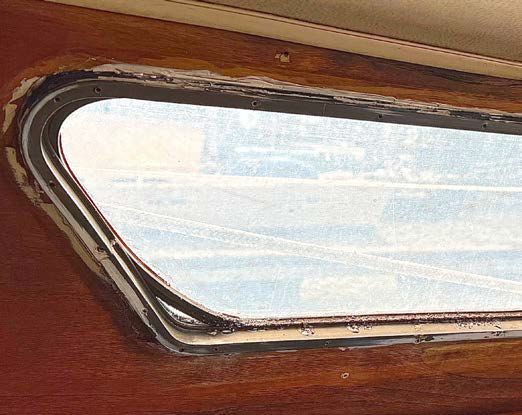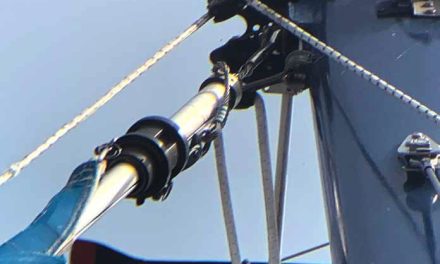Tips and tricks from a window replacement on a couple’s first sailboat
Issue 155: March/April 2024
Window replacements rarely fall under the category of “simple,” and this job on my newly acquired 1977 Islander 32 MK II wasn’t without its difficulties, but there were some simple tricks I learned along the way that made it much easier.
Three months ago, my wife, Betty, suggested out of nowhere that we spend a Saturday looking at sailboats. We live in the mountains on a sheep farm, so this was a bit of a surprise. We’d had a motorboat when we were dating, but I had no experience with sailing and Betty had zero interest in a powerboat. If I ever wanted to get back on the water, I needed to embrace the huge learning curve.
We drove three and a half hours to Urbanna, Virginia, on the Rappahannock River near the Chesapeake Bay. The first boat we saw was a 1977 Islander 32 MK II. It was priced at only $11,000, and Betty said, “Go for it!” Someone suggested getting a proper survey, but that cost didn’t really add up to us, so we just took a chance. Sometimes in life that’s what you have to do, and as we get older, there is less and less time for indecision. We are 64 and neither of us had ever owned a sailboat, but the only hope for some old boats is a new owner who is eager and willing to dive in and do the work. Thus, we adopted our Islander.

The original windows in the author’s Ilander were a leaky mess.
The boat turned out to be dry from the bottom up and wet from the top down. Some tape stopped one leak, but the windows were a mess. Digging into potential replacements, I was told that the original type of windows was unavailable. So I called Maritech Industries Inc. in California, which makes custom marine windows, and spoke with Mark — who, to my surprise, said he had made my boat’s first set of windows and would be happy to make her last set. Mark obviously knew everything about the Islander windows and had me take a lot of measurements. He strongly suggested making the windows out of tempered glass rather than plexiglass. The glass comes in tinted gray or bronze, and a local canvas expert advised that gray tint looks best on boats with a blue sail cover, dodger, and bimini. Bronze looks better with green or tan. It’s best to think this through with someone who understands colors.
Mark gave me detailed instructions to complete the installation. I’m sure there are many different techniques, but I figured I shouldn’t argue with the guy who has done it for a lifetime, and the knowledge Mark imparted to me was indispensable. The job turned out great, and I’m grateful to share some of what I learned in the process.
The best tip Mark provided was to round off one edge of a putty knife and tap it with a small mallet to remove the old silicone seal between the frame and the boat, working the putty knife between the window frame and the fiberglass and going all the way around. One thing to note is that Islander windows are held in by the interior frames, which I had already unscrewed. Some windows may be mounted differently, with bolts. Rounding the edge of the putty knife with my belt sander prevented it from digging into the frame and allowed it to travel smoothly around it.

Careful use of a wood chisel removes the majority of the old silicone.
Once the frame and window were off, I was left with the unenviable task of removing all the old silicone. I was skeptical about using a ¾-inch wood chisel to remove the remainder of the old sealant, but it was the perfect tool for the job. I purchased fine and extra fine Scotch-Brite pads to help with the final remnants. They both worked, but the fine pad was much quicker than the extra fine, and I didn’t notice any scratches. Scotch-Brite and acetone removed the rest of the old caulk, and denatured alcohol took care of the acetone residue. I then cleaned the window frames with alcohol to remove any oil left by my fingers.
Another tip is to fit the window on a dry run before applying caulk, silicone, or whatever you choose to go with. (Don’t ask me how I know.) For any tight spots that don’t quite seem to fit, you can use a Dremel tool with a sanding drum to shave them down. When it’s time to handle the window for installation, use a glass suction cup from your local hardware store — it’s eight bucks well spent.
From there, tape the windows to a point near the edge but leave a little area on the radius. The caulk bead needs to be the size of your little finger, which is a lot of caulk. I took Mark’s advice and used Dowsil 795 Silicone Building Sealant, applying it to the windows only and not to the fiberglass. If you miss, you don’t want to be cleaning silicone off the frames; you can avoid that problem by applying it only to the inside lip of the frames. Once the caulk is applied, time becomes somewhat limited.
After installing the windows, though you might be tempted, do not push them from the outside. Instead, use the screws to pull them in. Start with the center screws and work out to alternating sides until the window is pulled into place. The frame is plastic, so don’t tighten the screws too much. In my install, I stripped one screw, but fortunately I had another screw in the next size up and corrected my mistake.
When the screws are tightened, work as swiftly as possible to remove the excess caulk before it hardens. For this, my thumbnail and paper towels worked great. The final step was to immediately pull the tape and dip my finger in turpentine for one final wipe to smooth the edges.
The result is a window that is better than the Islander had when new, and the tempered glass provides a crystal clear view that we didn’t have from the cabin before.
I’ve never bonded with anything without being invested in the creative process, and that’s certainly how it is with my 1977 Islander 32 MK II. Sure, there’s still a long way to go, but my affection for her will only grow.

The view through the new window is much better!
Brian Richardson and Betty Mitchell dated in high school before she went in 1977 to Franklin College on Lake Lugano in the mountains of Switzerland, where she began sailing. A decade later, they became reacquainted, got married, and honeymooned on the Rappahannock River near the Chesapeake Bay. They’ve since moved to a mountaintop farm in Virginia, where they live and raise sheep, but they dock their 1977 Islander 32, Lugano, directly across the river from where they honeymooned.
Thank you to Sailrite Enterprises, Inc., for providing free access to back issues of Good Old Boat through intellectual property rights. Sailrite.com





